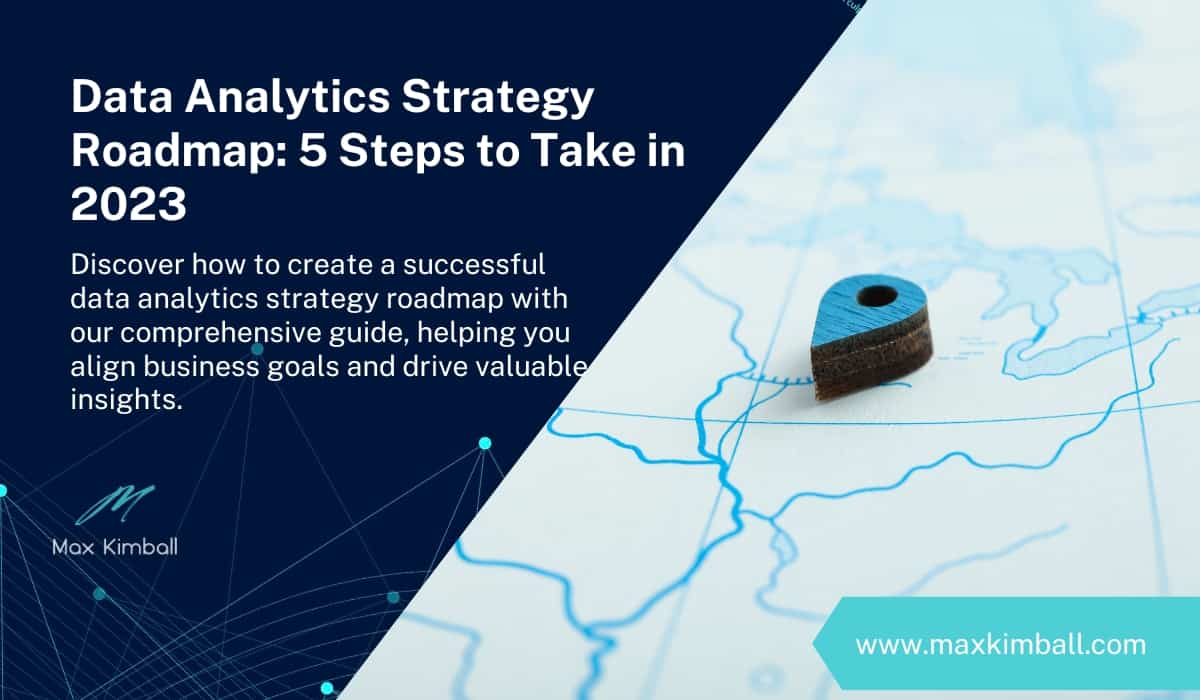Data Analytics Strategy Roadmap: 5 Steps to Take in 2023

As the world of data continues to expand, a well-defined data analytics strategy roadmap is essential for businesses seeking to harness the power of their information. In this article, we will examine the intricacies of forming and executing an efficient data analytics strategy roadmap that is compatible with your organization’s objectives.
We will explore the benefits of creating a comprehensive plan, including improved decision-making capabilities and increased revenue potential. Additionally, you’ll learn about the crucial steps involved in crafting a successful roadmap – from identifying key business objectives to establishing robust data governance programs.
Furthermore, we will discuss how to differentiate between a data strategy and an analytics roadmap while ensuring both components work seamlessly together. Finally, our expert advice on best practices when developing your own customized approach will provide invaluable insights for maximizing your organization’s potential through strategic use of its valuable data resources.
Table of Contents:
- What is a Data Analytics Strategy Roadmap?
- Benefits of Developing a Data Analytics Strategy Roadmap
- Steps for Developing a Data Analytics Strategy Roadmap
- Difference Between Data Strategy vs Analytics Roadmap
- 5 Best Practices When Developing a Data Analytics Strategy Roadmap
- FAQs in Relation to Data Analytics Strategy Roadmap
- Conclusion
What is a Data Analytics Strategy Roadmap?
A data analytics strategy roadmap is a comprehensive plan that outlines the steps and processes needed to achieve specific goals related to data analysis. It includes objectives, strategies, tactics, and timelines for implementation. A roadmap of this kind is meant to aid organizations in enhancing their data analytics capabilities, so they can make decisions based on the understanding gained from their data.
The primary purpose of developing such a roadmap is to ensure that an organization’s resources are allocated effectively toward achieving its data-related goals. By having a clear understanding of what needs to be accomplished and how it can be achieved, organizations can avoid potential pitfalls or inefficiencies in their approach to handling large volumes of complex information.
Data Analysis Objectives
- Identify opportunities: A well-defined analytics strategy should help you uncover new business opportunities by analyzing trends and patterns within your industry or market segment.
- Informed decision-making: The ultimate goal of any data-driven initiative is better decision-making across all levels of an organization – from strategic planning down through daily operations management.
- Predictive modeling: With advanced analytical techniques like machine learning algorithms at your disposal, you can develop predictive models that provide valuable foresight into future outcomes based on historical performance metrics.
Data Analysis Strategies & Tactics
To achieve these objectives, it’s essential first to identify the most appropriate strategies and tactics suited for your organization’s unique requirements. Some common approaches include:
- Determining which tools or platforms best align with your existing infrastructure;
- Leveraging external expertise through consulting services or partnerships;
- Creating a data-driven culture that encourages collaboration and innovation among team members;
- Implementing robust security measures to protect sensitive information from unauthorized access or misuse.
In addition to these strategies, it’s crucial to establish clear timelines for each step in the process. Timelines should be set to track progress, enabling reviews and adjustments if needed.
A data analytics strategy roadmap is a tool used to help organizations plan and execute their data-driven initiatives. Creating a data analytics strategy roadmap offers numerous advantages, which will be explored in the following section.
A data analytics strategy roadmap is a plan that outlines the steps and processes needed to achieve specific goals related to data analysis. It helps organizations allocate their resources effectively toward achieving their objectives, such as identifying opportunities, making informed decisions, and developing predictive models. To accomplish these goals, organizations must identify appropriate strategies and tactics while establishing clear timelines for each step in the process.
Benefits of Developing a Data Analytics Strategy Roadmap
Developing a data analytics strategy roadmap can bring numerous advantages to an organization, from streamlining processes to maximizing the value derived from its data. Here are some key benefits that organizations can experience by creating and implementing a well-defined roadmap:
- Better decision-making: A robust data analytics strategy enables organizations to make more informed decisions based on insights gleaned from their data. This leads to improved operational efficiency, reduced costs, and increased revenue.
- Improved resource allocation: By identifying priorities and setting clear objectives in the roadmap, organizations can allocate resources more effectively towards high-impact projects that drive business growth.
- Informed investments in technology: With a comprehensive understanding of current capabilities and future goals outlined in the roadmap, businesses can make smarter investments in technology solutions tailored specifically for their needs. For example, they might choose between different data analytics tools.
- Cross-functional collaboration: A well-designed data analytics strategy brings together stakeholders from various departments within an organization. This fosters better communication and collaboration among teams working towards common goals related to data analysis.
- Faster time-to-insight: Having clearly defined steps for collecting, processing, analyzing, and visualizing data helps reduce delays caused by inefficient processes or lack of clarity around roles and responsibilities. As a result, organizations gain valuable insights faster than before.
A successful implementation of your organization’s data analytics strategy roadmap can lead to significant improvements in business performance and a competitive edge in the market. Investing in the creation of a data analytics strategy roadmap can be beneficial for long-term success, enabling informed decisions to be made through leveraging data.
Having a data analytics strategy roadmap can provide many benefits to an organization, such as improved decision making and better use of resources. Let’s now explore the process of creating a data analytics strategy roadmap that could lead to enhanced decision-making and more effective utilization of resources.
Steps for Developing a Data Analytics Strategy Roadmap
In order to create an effective data analytics strategy roadmap, it is essential to follow a structured approach that will help you identify the necessary steps and processes needed to achieve your goals related to data analysis. Here are some key steps in developing a successful data analytics strategy roadmap:
Step 1: Define Objectives
The first step in creating a data analytics strategy roadmap is defining the objectives of the project. Identifying where enhancements or modifications are necessary, assessing the organization’s current data analysis aptitude and resources should be included when setting objectives for the project. It is crucial to have clear and measurable objectives so that progress can be tracked throughout the process.
Step 2: Assess Current Capabilities and Resources
Once you have defined your objectives, assess your organization’s current capabilities and resources available for achieving these goals. This includes evaluating existing tools, technologies, personnel skills, and processes related to data collection, storage, management, and analysis. Identifying gaps between current capabilities and desired outcomes will help inform decisions about which strategies or tactics should be implemented.
Step 3: Develop Strategies & Tactics
The next step involves developing strategies and tactics that align with your defined objectives while addressing any identified gaps in capabilities or resources. For example, this may involve implementing new analytics tools, enhancing existing ones or improving internal processes such as training staff on new techniques or methodologies. Ensure that the chosen strategies and tactics are realistic, achievable, and scalable to meet your organization’s needs.
Step 4: Establish Timelines & Milestones
Establishing timelines and milestones for each step of the roadmap is essential to ensure progress towards desired outcomes. This includes setting milestones for achieving specific goals or completing tasks related to data analytics initiatives. Having well-defined timelines helps keep everyone involved accountable while ensuring that you are working toward achieving a desired outcome.
Step 5: Monitor Progress & Adjust as Needed
An essential aspect of any successful data analytics strategy roadmap is ongoing monitoring and evaluation of progress against established goals and milestones. Regularly reviewing progress allows you to identify potential issues early on so they can be addressed accordingly before becoming major roadblocks. Additionally, this process enables you to make adjustments as needed based on changing circumstances or emerging opportunities within your organization.
By following these steps when developing a data analytics strategy roadmap, organizations can effectively plan their journey towards improved data analysis processes while maximizing resources and personnel utilization.
Developing a data analytics strategy roadmap requires careful planning and execution, but with the right steps it can be achieved. Moving on to discuss the difference between data strategy vs analytics roadmap will help you understand how they are different from each other and why one is better than the other in certain situations.
To develop a successful data analytics strategy roadmap, organizations should follow a structured approach that includes defining objectives, assessing current capabilities and resources, developing strategies and tactics, establishing timelines and milestones, and monitoring progress. By doing so, they can identify gaps in their processes while maximizing resources to achieve desired outcomes.
Difference Between Data Strategy vs Analytics Roadmap
A common misconception is that data strategy and analytics roadmap are interchangeable terms, but they have distinct differences in their focus areas. To better understand the distinction between these two concepts, let’s explore each one individually.
Data Strategy
Data strategy revolves around how an organization collects, stores, manages, and uses its data to achieve business goals. It encompasses various aspects of data management such as:
- Data governance: Establishing policies and procedures for managing data quality and consistency across the organization.
- Data architecture: Designing the structure of databases and systems to store information efficiently.
- Data integration: Combining different sources of data into a unified view for analysis purposes.
- Data security: Protecting sensitive information from unauthorized access or misuse by implementing appropriate measures like encryption or access controls.
In essence, a well-defined data strategy ensures that organizations can make informed decisions based on accurate and reliable information while maintaining compliance with regulations regarding privacy and security standards. For more insights on developing a successful data strategy, check out this comprehensive guide by McKinsey & Company.
Analytics Roadmap
On the other hand, an analytics roadmap focuses specifically on how organizations analyze their collected data to gain valuable insights for decision-making processes. This involves identifying key performance indicators (KPIs), selecting suitable analytical tools or techniques (e.g., descriptive statistics, predictive modeling), and establishing best practices for interpreting results accurately without bias.
Some essential components of an analytics roadmap include:
- Identifying business objectives and KPIs that align with the organization’s overall goals.
- Selecting appropriate data sources, analytical tools, and techniques to address specific questions or problems.
- Establishing a process for continuous improvement by regularly reviewing the effectiveness of current analytical approaches and adapting them as needed based on new insights or changing circumstances.
To achieve improved performance, increased efficiency, and better customer experiences, an analytics roadmap should be developed that enables organizations to make decisions based on data. For more information on creating a successful analytics roadmap, consider reading this informative article from Tableau.
In Summary
To sum up the key differences between these two concepts: A data strategy focuses on managing all aspects of an organization’s data lifecycle (collection, storage, integration), while an analytics roadmap is concerned with extracting meaningful insights from available data using various analysis methods. Both are crucial elements in achieving success in today’s increasingly competitive business landscape driven by digital transformation initiatives. By understanding their unique roles within your organization’s overall strategy, you can effectively leverage each one for maximum impact.
It is important to understand the difference between data strategy and analytics roadmap in order to develop a successful data analytics strategy. Therefore, it is essential to review best practices when developing a data analytics strategy roadmap for maximum success.
Data strategy and analytics roadmap are two distinct concepts that play a crucial role in achieving success in today’s competitive business landscape. While data strategy focuses on managing all aspects of an organization’s data lifecycle, analytics roadmap is concerned with extracting meaningful insights from available data using various analysis methods. Understanding their unique roles within the overall strategy can help organizations leverage each one for maximum impact.
5 Best Practices When Developing a Data Analytics Strategy Roadmap
Developing an effective data analytics strategy roadmap is crucial for organizations to successfully leverage their data and gain valuable insights. It’s essential to adhere to practices that promote collaboration, realistic goal-setting, and continual enhancement in order for your roadmap to be successful. To ensure the success of your roadmap, it is important to incorporate key best practices that involve stakeholders from all areas of the organization and practices that align with your business goals.
Involve Stakeholders from All Areas of the Organization
Involving stakeholders from various departments ensures that everyone has input into the process and understands their role in achieving success with the project. This collaborative approach helps create a comprehensive plan that addresses different perspectives and needs within the organization. Cross-functional collaboration also fosters innovation by bringing together diverse skill sets and expertise.
Set Realistic Goals and Timelines
A successful roadmap requires setting achievable goals based on your organization’s current capabilities, resources, and priorities. Establishing clear objectives allows team members to focus on specific tasks while ensuring progress can be tracked throughout the process.
- Short-term goals: These are immediate milestones or improvements needed within weeks or months.
- Middle-term goals: These involve more complex projects requiring several months up to a year.
- Long-term goals: Long-range plans typically span multiple years as they involve significant changes in infrastructure or processes.
By breaking down larger objectives into smaller steps with realistic timelines, you can maintain momentum while minimizing frustration among team members.
Regularly Review Progress Against Goals
Monitoring progress is essential for identifying potential issues early on and adjusting your data initiatives as needed. Establish a schedule for regular progress reports, including key performance indicators (KPIs) that measure the success of your data analytics initiatives. Regular assessments should be made to ensure that objectives are being met, pinpoint areas in need of extra help or resources, and make informed decisions about any modifications needed for the plan.
Continuously Improve Your Data Analytics Strategy Roadmap
A good roadmap should not remain static; data initiatives must evolve over time as new technologies emerge, organizational priorities shift, and lessons are learned from previous projects. Encourage a culture of continuous improvement by regularly reviewing your roadmap’s effectiveness and making adjustments based on feedback from stakeholders and team members.
Continuous improvement in data science teams helps ensure that your organization remains agile in response to changing business needs while maximizing the value derived from its data assets.
Developing an effective data analytics strategy roadmap requires involving stakeholders from all areas of the organization, setting realistic goals and timelines, regularly reviewing progress against goals, and continuously improving the roadmap. By breaking down larger objectives into smaller steps with achievable timelines, organizations can maintain momentum while minimizing frustration among team members. Regularly monitoring progress is essential for identifying potential issues early on and adjusting strategies as needed to ensure success in leveraging data assets.
FAQs in Relation to Data Analytics Strategy Roadmap
What is a data analytics roadmap?
A data analytics roadmap is a strategic plan that outlines the steps and milestones for implementing data-driven decision-making processes within an organization. It helps businesses prioritize their goals, allocate resources effectively, and track progress towards achieving desired outcomes using insights derived from analyzing large volumes of structured and unstructured data.
How do you create a data strategy roadmap?
1. Define your business objectives
2. Identify key stakeholders
3. Assess the current state of your organization’s data capabilities;
4. Determine required tools, technologies, and skills
5. Establish governance policies and procedures
6. Develop implementation plans with timelines and milestones
7. Monitor progress regularly to ensure alignment with overall business goals.
How do you develop a data analytics strategy?
Developing a successful data analytics strategy involves understanding organizational needs, setting clear objectives aligned with those needs, identifying relevant metrics to measure success against those objectives, selecting appropriate analytical tools and techniques based on available resources and expertise levels in-house or through external partners, and establishing strong governance frameworks around how collected information will be managed responsibly throughout its lifecycle.
What are the four pillars of data strategy?
– Data Governance (establishing rules for handling sensitive information)
– Data Architecture (designing systems that facilitate efficient storage and retrieval)
– Data Integration (ensuring seamless flow between disparate sources)
– Data Analytics (applying advanced statistical methods to derive actionable insights)
Conclusion
In conclusion, a data analytics strategy roadmap is an essential tool for any organization looking to make informed decisions based on data. By following the steps discussed and implementing proper procedures, companies can craft a plan that is tailored to their objectives and optimizes the usage of data.
It’s important to remember that developing a successful roadmap takes time and effort, but the benefits are worth it. With a clear plan in place, organizations can improve efficiency, reduce costs, and gain a competitive advantage.
If you’re ready to take your company’s data analytics capabilities to the next level with a well-designed strategy roadmap, follow Max Kimball’s blog to stay in the loop.







3 Comments
Comments are closed.